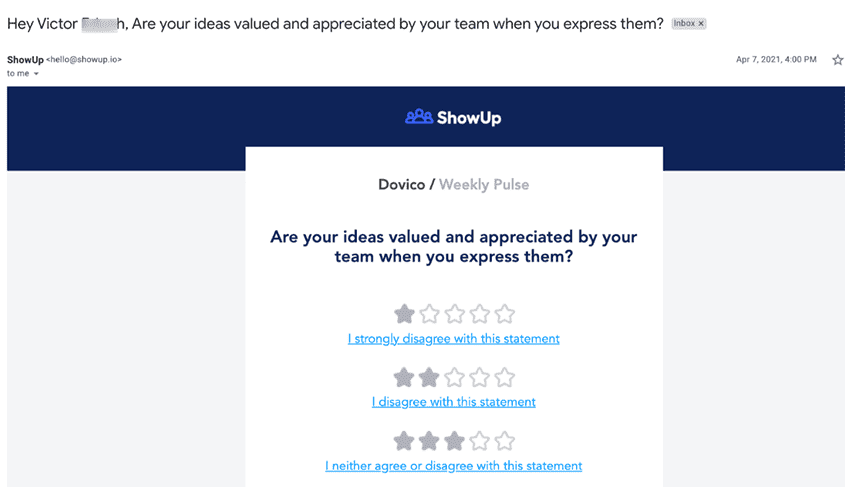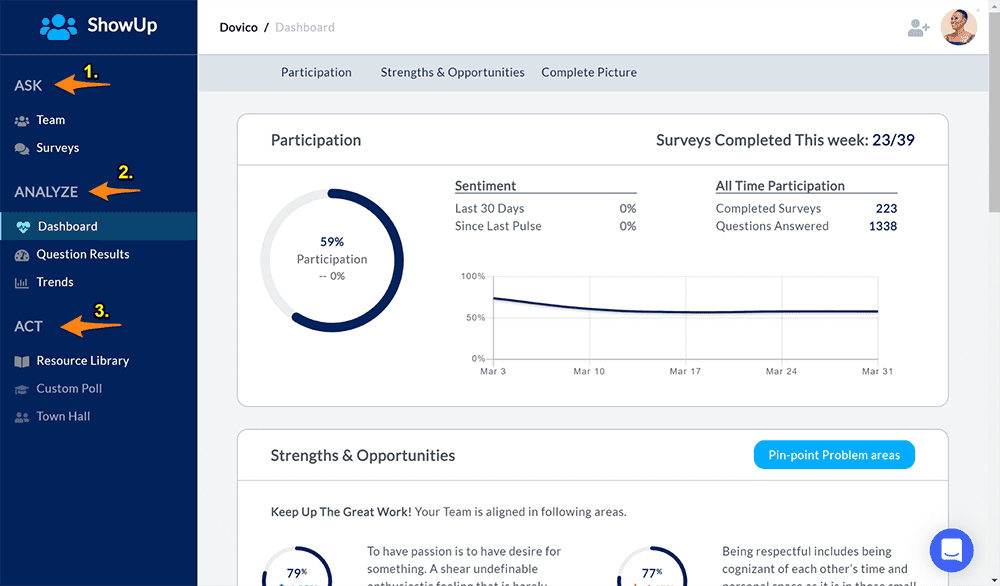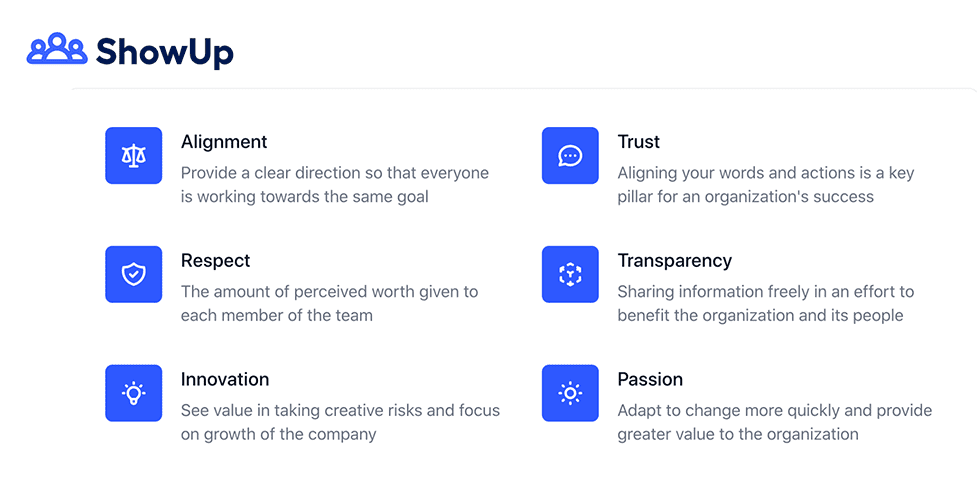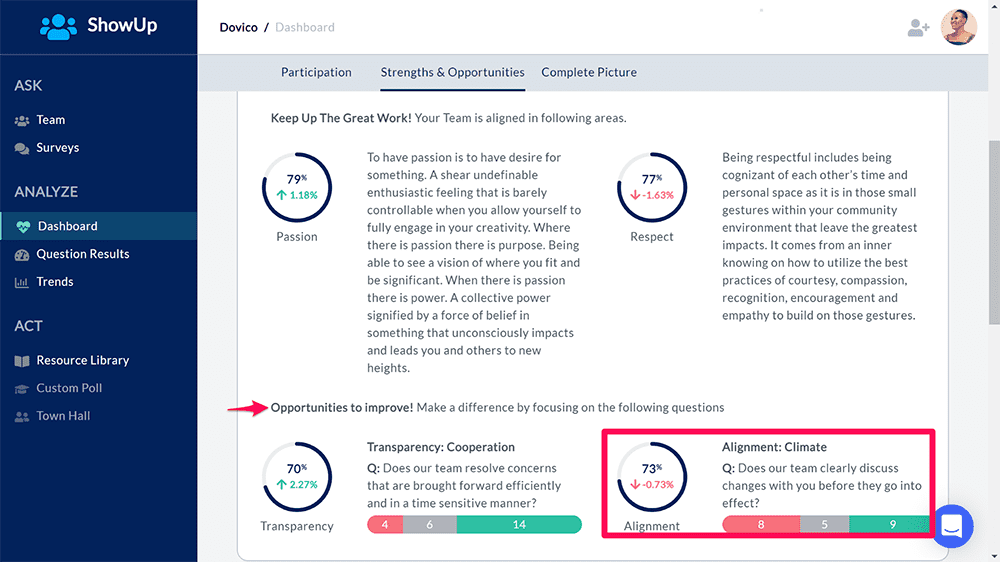A Manager's SurveyMonkey Alternative for Employee Engagement
When people think of surveys, they think SurveyMonkey.
And that’s understandable. SurveyMonkey has earned its reputation with numbers that speak for themselves. Founded in 1999, they’ve grown to millions of users with revenues north of $100 million in 2020.
This growth made SurveyMonkey so popular. So much that they’ve become people’s first point of stop when searching for anything online surveys.
But you’re not “people,” and you’re not just after “online surveys.”
You’re a manager eager to measure and improve employee engagement regularly. So you should think beyond SurveyMonkey. And that’s because it lacks weekly or bi-weekly automated team pulse survey capabilities for measuring and improving employee engagement regularly.
There’s another reason to seek a SurveyMonkey alternative.
Using it to measure and improve employee engagement is like fitting a square peg into a round hole. Because besides being more suited for annual, external surveys, SurveyMonkey isn’t built specifically for managers.
The company’s public pages with its employee survey templates and engagement product, SurveyMonkey Engage, confirm this.
These pages’ meta descriptions (or summaries) reveal they’re focused on:
[Giving] you the tools to ask employees about their motivation and job satisfaction…” And “[empowering] HR teams to improve engagement…
In other words, their core focus is on motivation and employee satisfaction, not engagement. And even when they touch on engagement, it’s for HR teams, not managers like you.
These voids, which you’ll see more of in this article, have given rise to employee engagement alternatives to SurveyMonkey.
One of which is ShowUp.
ShowUp is built from the ground up to help managers measure and boost team engagement regularly. The product comes ready with automated weekly or bi-weekly team pulse surveys sent directly to your employees’ inboxes.
For instance, ShowUp automatically sent this survey to help a manager measure engagement by gauging how employees felt about their shared ideas:

[Employees simply participate in these engagement surveys by clicking an option, while ShowUp does the rest heavy-lifting]
Automatically Measure & Get Real-time Insights for Improving Employee Engagement
Why SurveyMonkey Isn’t Great for Employee Engagement
SurveyMonkey is an excellent online survey tool, no questions there.
They’ll get full credits as a mass feedback collection software any day. But for a manager concerned about employee engagement, do you really want to leave that to a 42-question survey that takes employees a quarter of an hour to fill?
If you answered ‘no,’ which you should, below are other reasons to consider SurveyMonkey alternatives for employee engagement.
1. It Doesn’t Reveal How Employees Deeply Feel
With SurveyMonkey, you send out a 42-question engagement survey once a year. But think about this for a moment.
Isn’t doing that like having your company visit the doctor to diagnose your employees’ temperature level all year long on a single day?
It’s more like it, and here’s why that’s not reliable.
The doctor may tell you how hot or cold they’re on that day, but they can’t diagnose how they’ve felt the days, weeks, and months before. Neither can such a one-time diagnosis reveal how engaged they’ll be in the days, weeks, and months after.
And here’s the worst part.
You can’t rely on a one-time annual questionnaire to know how the people you manage feel or how engaged they’re towards the work they do daily.
Employees’ engagement levels fluctuate daily.
To stand a chance of improving it the moment it goes south, you must measure how your team members feel weekly or bi-weekly, not yearly.
Unfortunately, SurveyMonkey doesn’t do this.
2. SurveyMonkey’s Engagement Surveys Aren’t Anonymous
Common knowledge says you can’t eat your cake and still have it, and we all accept. But when it comes to measuring how engaged employees are, SurveyMonkey somehow goes against this timeless wisdom.
Here’s how.
To gauge how engaged employees you manage are, they must speak without fear that what they say won’t be traced back to them. And this means giving them total anonymity to fill your survey freely.
Unfortunately, that’s not the case with SurveyMonkey’s anonymous survey feature, which this report found is not truly anonymous.
3. It Requires Data-Crunching Skills to Interpret Results,
Data not interpreted correctly offers little to no value.
You may insist on using SurveyMonkey for employee engagement because of its freemium plan, which by the way, is very limited. However, the data you get from engagement survey results collected with SurveyMonkey does not come pre-interpreted.
You’ll need some data-crunching and spreadsheet ninja skills to make sense of your survey results. According to this report:
Talk to anyone who has used SurveyMonkey for their work, and you’ll get an ear full about how much time they spend fumbling with the interface and harnessing the data collected in spreadsheets.
4. Employees May Not Complete Your SurveyMonkey Surveys
What’s the point of sending out surveys with too many questions your employees won’t complete, or do so, absent-minded?
The answer to that question is obvious, none.
SurveyMonkey’s engagement surveys are 42-questions long and take over a quarter of an hour to complete. And that’s for someone fully committed to filling it out. But let’s face it.
The employees you manage are busy. And for the most part, don't like to fill surveys. Especially surveys that take that much time and effort to complete.
So relying on SurveyMonkey’s long surveys to gauge employee engagement could lead to low completion rates or total abandonment.
As a manager, you wouldn’t want that, right?
Introducing a Manager’s SurveyMonkey Employee Engagement Alternative
Managers (like you) shoulder many responsibilities.
The job-defining one is leading your team to achieve company goals. And this involves making sure all employees are engaged at work every day.
To do this, you must gauge engagement levels at least weekly, not yearly, as SurveyMonkey does.
And that’s where ShowUp comes in.
ShowUp automates the entire employee engagement process by sending bite-sized weekly or bi-weekly pulse surveys for you. Ultimately, it enables you to Ask, Analyze, and Act on improving engagement, all from one dashboard:

[ShowUp brings your people analytics & survey data under one roof]
Automatically Measure & Get Real-time Insights for Improving Employee Engagement
Why Choose ShowUp as Your Employee Engagement Alternative to SurveyMonkey?
SurveyMonkey was built for anything online surveys.
It’s for this reason most people, like this report, consider it more of a generic feedback tool, which by all means, is good for gathering external feedback.
However, the question remains:
Why should managers choose a dedicated employee engagement tool like ShowUp over SurveyMonkey?
Let’s see.
1. It Frees You to Lead, Not Wasting Time Sending Surveys
Unlike SurveyMonkey, where you must create and send these surveys yourself, ShowUp automates the entire process for you.
Weekly or bi-weekly, however you prefer, just choose, and ShowUp will deliver pulse surveys straight into your employees’ inboxes:

2. Leverage Psychology-Backed Survey Questions, Not Generic Ones
SurveyMonkey offers templated employee engagement questions that are generic. But with ShowUp, you get questions on topics validated by a psychology professor.
These questions are specific and proven to measure and improve fundamental components of workplace trust and culture metrics.
These culture metrics directly affect employee engagement.
ShowUp breaks these metrics down into questions relevant to team engagement. They include Trust, Passion, Innovation, Alignment, Respect, and Transparency:

3. Easy-to-Interpret Insights that Spots Problem Areas
With ShowUp, you don’t need data-crunching skills. Neither do you need to be a spreadsheet ninja to interpret your weekly or bi-weekly survey results.
First, you get easy-to-interpret data populated in your dashboard seconds after each team member completes their survey. Also, ShowUp takes it a step further by highlighting opportunity areas to improve engagement:

4. Pre-Curated Resources on How to Improve Employee Engagement
ShowUp doesn’t stop at automating engagement surveys, crunching the data, and spotting out opportunities for improvement.
All that could still amount to nothing if you don’t know how to act on those opportunities. We know this.
It’s why, unlike SurveyMonkey, ShowUp is built with handpicked resources to help managers take action and improve employee engagement right into the software:

Conclusion: Measure & Improve Employee Engagement with ShowUp
Employee engagement surveys can only be effective if the results lead to positive change within your team and organization.
That’s not the case with SurveyMonkey, where after the survey results are in, its job is done. SurveyMonkey doesn’t offer an enlightened path to help managers make the change that your company culture deserves.
It’s why you should give ShowUp a try.
Besides automating the entire surveying process with bite-sized, easy-to-complete team pulse surveys, ShowUp also provides real-time insights, and handpicked resources you need to effect change.
